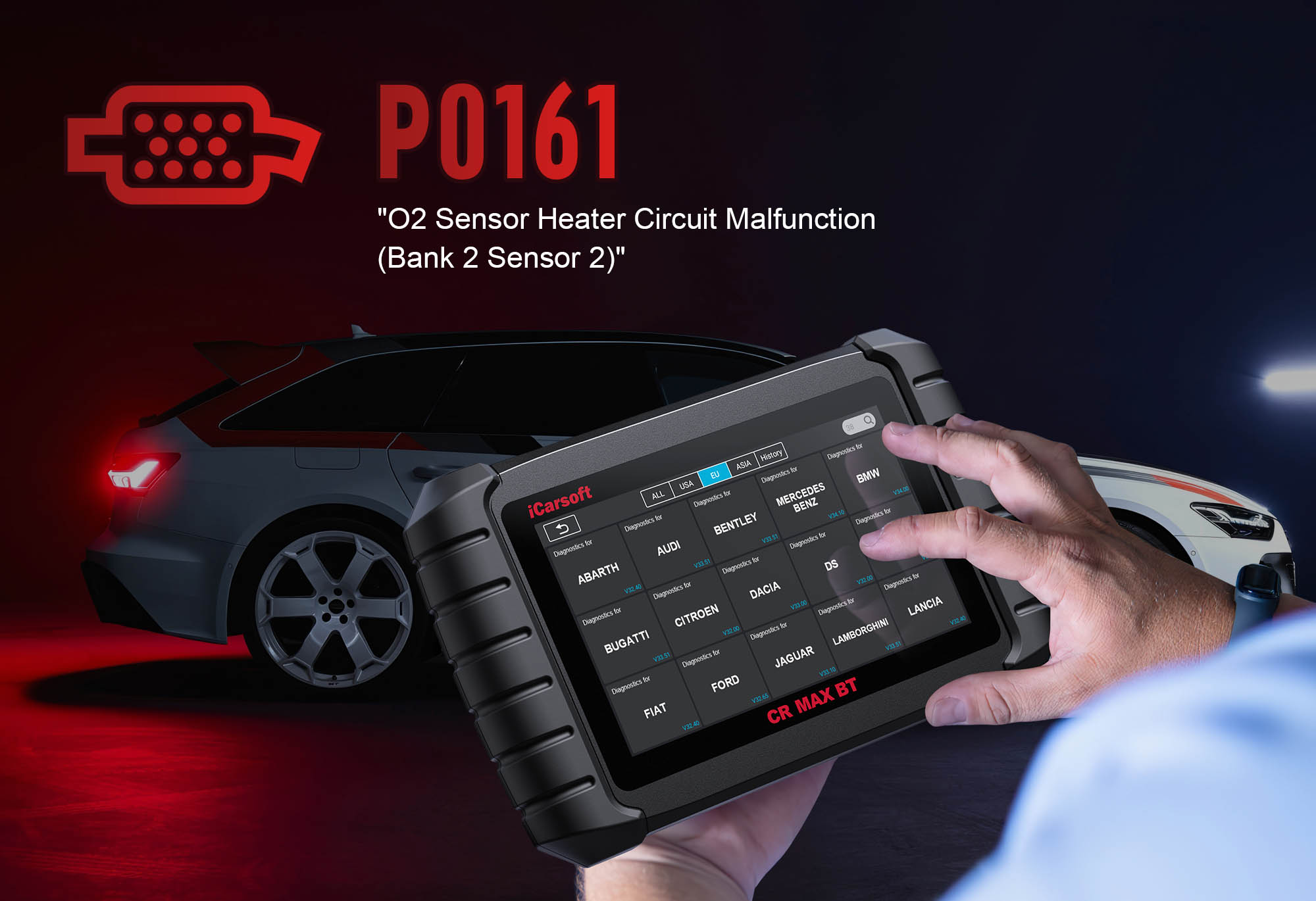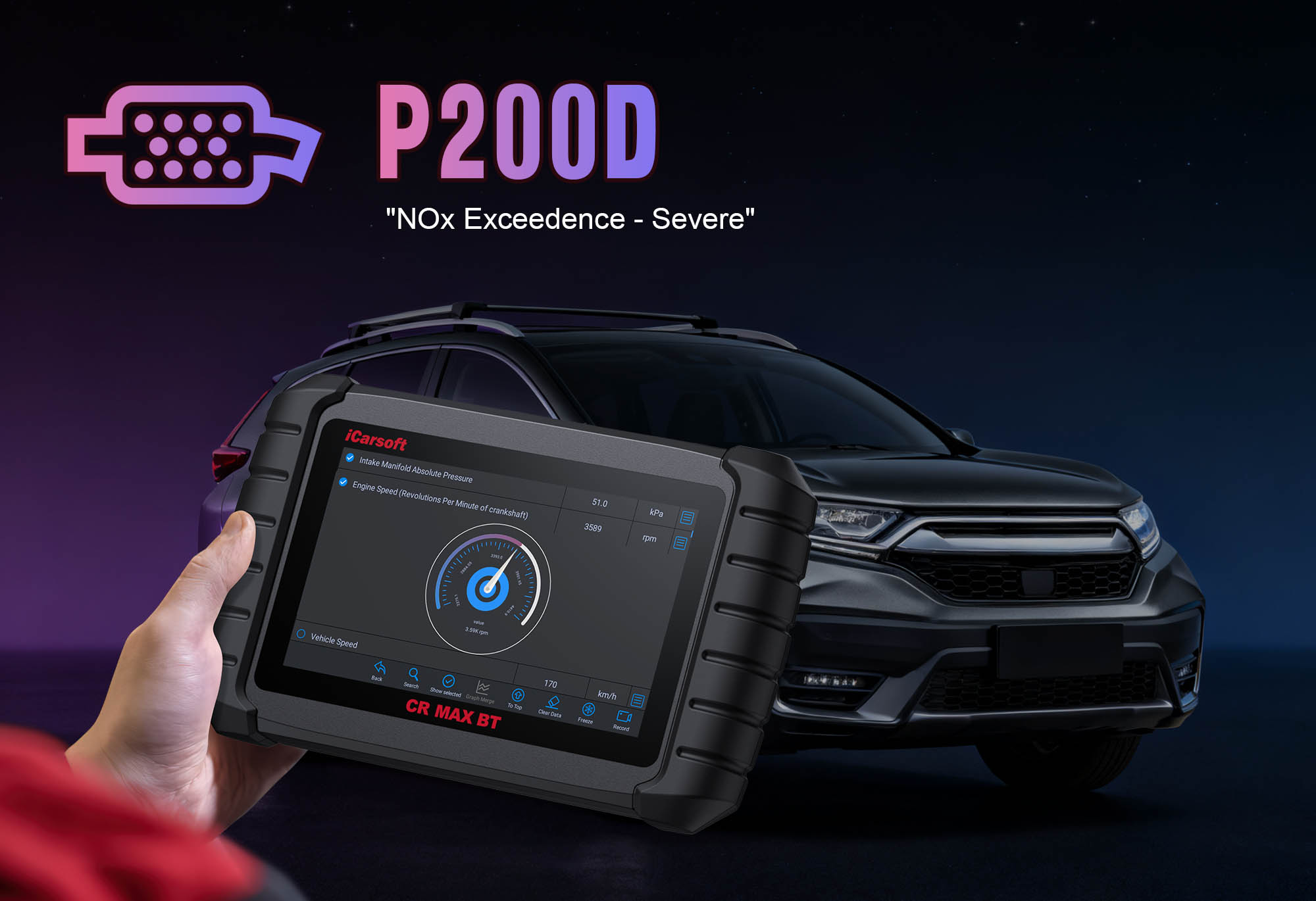Diagnose & Clear P0161 with iCarsoft CR MAX BT: Fix O2 Sensor Heater Circuit Malfunction (Bank 2, Sensor 2)
If your check engine light illuminates and a scan returns P0161, your vehicle’s emissions system is signaling a problem with the heater circuit of Bank 2’s downstream oxygen sensor. This OBD-II code stands for "Oxygen Sensor Heater Circuit Malfunction (Bank 2, Sensor 2)"—indicating the Engine Control Module (ECM) has detected an abnormal current or voltage in the heater element of the downstream O2 sensor in Bank 2.
Downstream oxygen sensors (mounted after the catalytic converter) rely on internal heaters to reach operating temperature quickly, ensuring accurate monitoring of exhaust gases to verify converter efficiency. When P0161 occurs, Bank 2’s downstream sensor heater fails to function properly—either shorting out, lacking power, or remaining inactive. This delays sensor readiness, leading to failed emissions tests, reduced fuel efficiency, and potential misdiagnosis of catalytic converter health.
Basic scanners may only label P0161 as a "heater fault" but can’t test circuit continuity or heater resistance. The iCarsoft CR MAX BT—with its wireless circuit testing, real-time heater current monitoring, and sensor resistance checks—solves this. Let’s walk through how to diagnose and resolve P0161 using this advanced tool.
 iCarsoft CR MAX BT displaying Bank 2, Sensor 2 heater voltage, current, and resistance data for P0161 diagnosis
iCarsoft CR MAX BT displaying Bank 2, Sensor 2 heater voltage, current, and resistance data for P0161 diagnosis
Understanding P0161: Causes & Key Symptoms
A faulty downstream O2 sensor heater in Bank 2 disrupts sensor performance, leading to specific issues:
Key Symptoms of P0161
-
Check Engine Light: Illuminates when the ECM detects no current flow, excessive current, or a voltage drop in the Bank 2, Sensor 2 heater circuit for 2+ drive cycles.
-
Delayed Sensor Readiness: The "Check Engine" light may take 5–10 minutes to activate as the ECM waits for the sensor to warm up passively.
-
Failed Emissions Tests: A cold downstream sensor can’t accurately verify catalytic converter efficiency, leading to test failures.
-
Inaccurate Converter Diagnostics: The ECM may misjudge converter health (e.g., flagging a healthy converter as failing) without valid sensor data.
-
Reduced Fuel Efficiency: Indirectly disrupts upstream sensor adjustments in some vehicles, lowering MPG by 5–8%.
-
Sensor Readiness Monitor Issues: The "O2 Sensor Readiness" monitor may show "Not Ready," blocking emissions testing until resolved.
Common Causes of P0161
|
Cause
|
Description
|
|
Faulty O2 Sensor Heater Element
|
Internal damage (broken wiring or burned-out coil) in Bank 2’s downstream sensor stops the heater from working—accounts for ~50% of P0161 cases.
|
|
Damaged Wiring or Connector
|
Frayed wires, corroded terminals, or loose plugs in the heater circuit disrupt power flow—worsened by undercarriage exposure to debris and moisture.
|
|
Blown Fuse or Relay
|
A dedicated fuse or relay for O2 sensor heaters is blown, cutting power to Bank 2’s downstream sensor (common in high-mileage vehicles).
|
|
Short Circuit
|
Heater wires touching the exhaust system or chassis create excessive current, triggering the ECM to log P0161.
|
|
ECM Malfunction (Rare)
|
A faulty ECM fails to send power to the heater circuit, usually paired with other electrical codes (e.g., P0606 or P0607).
|
Why iCarsoft CR MAX BT Excels at Diagnosing P0161
The CR MAX BT outperforms basic tools with features tailored to downstream O2 sensor heater diagnostics—critical for pinpointing P0161’s root cause:
Wireless Heater Circuit Monitoring
Streams real-time voltage and current data from the Bank 2, Sensor 2 heater circuit to your device, identifying shorts (high current) or open circuits (no current) instantly.
Heater Resistance Testing
Precisely measures the sensor’s heater element resistance to confirm if it’s within manufacturer specs (typically 5–15 ohms)—eliminating guesswork about heater health.
Fuse & Relay Identification
Accesses vehicle-specific diagrams to locate O2 sensor heater fuses/relays (e.g., "O2 HEATER 15A" in Nissan) with no manual lookup needed.
Dual Bank Comparison
Side-by-side data for Bank 1/Bank 2 O2 sensor heaters highlights discrepancies (e.g., Bank 1 heater works, Bank 2 shows 0A)—isolating Bank 2 issues.
Bi-Directional Heater Activation
Sends commands to activate the Bank 2, Sensor 2 heater directly, verifying if the ECM (not the sensor) is failing to supply power.
3D Component Diagrams
Shows Bank 2 layout, downstream sensor location (after catalytic converter), and heater circuit paths for 80+ makes (Nissan, Mazda, GMC, Jaguar).
Step-by-Step: Diagnose P0161 with iCarsoft CR MAX BT
-
1. Connect & Confirm the Code
Plug the CR MAX BT into your vehicle’s OBD-II port and pair it with your smartphone/tablet via the iCarsoft app (Bluetooth setup takes 30 seconds).
Select your vehicle using Auto VIN Scan (reads VIN instantly) or manual entry (make/model/year/engine).
Navigate to Engine > Fault Codes > Read Codes to confirm P0161. Tap Code Details for vehicle-specific insights (e.g., "Nissan: Bank 2, Sensor 2 Heater Voltage = 0V – No Power").
-
2. Identify Bank 2 & Locate the Downstream Sensor
Use the CR MAX BT to avoid confusion:
Bank 2 Identification:
Go to Component Location > Engine > Cylinder Banks. For V-engines, Bank 2 = cylinders farthest from the front (e.g., V8: Bank 2 = 2-4-6-8). For inline engines, Bank 2 = the only bank (rare for 4-cylinders).
Sensor Location:
Navigate to Component Location > Engine > Exhaust System > O2 Sensor (Bank 2, Sensor 2). The app displays a 3D diagram: Downstream sensors are mounted in the exhaust pipe after the catalytic converter, with a 4-wire connector (2 for the sensor, 2 for the heater).
-
3. Analyze Live Heater Circuit Data
The CR MAX BT’s real-time data reveals heater circuit issues:
Start the engine and let it run for 5 minutes (to activate the sensor heater).
In the app, go to Engine > Live Data > Exhaust System and select Bank 2 metrics:
- "O2 Sensor Heater Voltage (Bank 2, Sensor 2)": Normal = 12V (battery voltage). P0161 = 0V (no power) or >14V (overvoltage).
- "O2 Sensor Heater Current": Normal = 0.5–1.5A. 0A = open circuit; >2A = short circuit.
Compare to Bank 1: If Bank 1’s heater works but Bank 2’s doesn’t, the issue is isolated to Bank 2’s sensor or wiring.
-
4. Inspect the Sensor Connector & Wiring
Physical damage or corrosion is often the cause—check with guidance from the CR MAX BT:
Connector Check:
Disconnect the Bank 2, Sensor 2 connector. Look for:
- Corrosion (white/green deposits) on the heater terminals (usually labeled "HT+" and "HT-").
- Bent pins or water intrusion (common in undercarriage locations exposed to rain/snow).
Clean terminals with electrical contact cleaner; straighten bent pins carefully.
Wiring Inspection:
Follow the wiring from the sensor to the ECM (use the app’s diagram). Check for:
- Frayed insulation (from heat or road debris).
- Wires touching hot components (e.g., exhaust pipe) that could cause shorts.
-
5. Test the O2 Sensor Heater Resistance
A faulty heater element is the top cause—test it with the CR MAX BT:
Turn off the engine and disconnect the sensor connector.
Navigate to Special Functions > Sensors > O2 Sensor Heater Test in the app.
Connect the scanner’s test leads to the sensor’s heater pins (refer to the app’s pinout guide for your vehicle).
Measure resistance:
- Normal = 5–15 ohms (varies by manufacturer—check the app’s specs).
- 0 ohms = shorted heater (replace the sensor).
- Infinite ohms = open heater (replace the sensor).
-
6. Check Fuses & Relays
A blown fuse or bad relay cuts power to the heater—diagnose with the CR MAX BT:
Fuse Check:
Go to Component Location > Electrical > Fuse Box to find the O2 sensor heater fuse (labeled "O2 HEATER," "SENSOR HT," or similar).
Use the app’s Fuse Test function to check continuity: 0 ohms = good; infinite = blown. Replace with an OEM-spec fuse if needed.
Relay Check:
Locate the O2 sensor heater relay (near the fuse box). Use the CR MAX BT’s Relay Test to activate it—listen for a "click" (working relay) or silence (faulty relay). Replace if silent.
-
7. Diagnose Wiring for Shorts/Opens
A broken or shorted wire disrupts the heater circuit—test with the CR MAX BT:
Short Circuit Test:
Navigate to Special Functions > Electrical Tests > Short Circuit Test.
Connect one test lead to the sensor’s heater power wire (at the connector) and the other to the vehicle’s chassis (ground).
A reading <5 ohms = wire is shorted to ground (look for damaged insulation touching metal).
Continuity Test:
Verify wiring between the sensor’s heater terminals and the ECM (use the app’s wiring diagram). Resistance >1 ohm = broken wire—repair with heat-shrink connectors.
-
8. Verify ECM Heater Control
Rule out an ECM fault with the CR MAX BT’s bi-directional control:
Navigate to Special Functions > ECM > Heater Circuit Test.
The app sends a command to the ECM to activate the Bank 2, Sensor 2 heater. Monitor live data:
- If voltage/current jumps to normal (12V/0.5–1.5A) = ECM works.
- If voltage/current remains 0 = ECM may be faulty (consult a professional for further testing).
-
9. Repair & Clear P0161
Fix the Root Cause:
- Replace the Bank 2, Sensor 2 O2 sensor (use OEM for accuracy—check the app’s Part Lookup tool).
- Repair shorted/broken wiring with heat-shrink butt connectors; replace severely damaged harnesses.
- Replace blown fuses or faulty relays with OEM-spec parts.
- Clean corroded connectors and apply dielectric grease to prevent future moisture damage.
Clear the Code: In the app, go to Engine > Fault Codes > Clear Codes to delete P0161.
-
10. Validate the Repair
Confirm the heater circuit works correctly:
- Start the engine and recheck live data—heater voltage should read 12V, current 0.5–1.5A.
- Let the engine run for 10 minutes—ensure the "O2 Sensor Readiness" monitor (in Monitor Status) shows "Ready."
- Take a 15-minute test drive (city + highway) and re-scan with the CR MAX BT: No P0161 recurrence = successful repair.
Preventing P0161 Recurrence
The CR MAX BT helps maintain reliable downstream O2 sensor heater performance long-term:
-
Sensor Maintenance: Use the app’s Service Reminder to replace downstream O2 sensors every 100,000–150,000 miles (heaters degrade over time).
-
Wiring Protection: Secure sensor wiring away from hot exhaust components using heat-resistant loom tape to avoid insulation damage.
-
Connector Care: Apply dielectric grease to the sensor plug annually to repel moisture and prevent corrosion.
-
Fuse Checks: Include O2 sensor heater fuses in your regular maintenance (every 6 months) to catch blown fuses early.
-
Software Updates: Keep the CR MAX BT updated via Wi-Fi to ensure compatibility with new O2 sensor technologies and vehicle models.
Conclusion
P0161’s downstream O2 sensor heater malfunction in Bank 2 may seem minor, but it disrupts critical emissions monitoring and catalytic converter diagnostics. The iCarsoft CR MAX BT simplifies diagnosis with wireless circuit testing, heater resistance checks, and vehicle-specific guides—ensuring you fix the root cause, whether it’s a faulty sensor, wiring, or fuse.
With the CR MAX BT, resolving "heater circuit faults" becomes a precise, streamlined process—keeping your vehicle’s emissions system compliant, efficient, and ready for emissions testing.
FAQs About P0161 Code
Q: Can I drive my vehicle with P0161?
A: Yes, but fix it within 1–2 weeks. P0161 doesn’t cause immediate engine damage, but it delays sensor readiness and risks failed emissions tests. Prolonged driving may also mask catalytic converter issues, leading to costlier repairs later.
Q: How much does it cost to fix P0161?
A: Costs are moderate: Downstream O2 sensor = $60–$140 (DIY); fuse/relay = $10–$30; wiring repair = $20–$50. Professional labor = $100–$200 (if the sensor is hard to access, e.g., near the rear exhaust). The CR MAX BT avoids overspending on unnecessary ECM repairs.
Q: Why does P0161 come back after replacing the O2 sensor?
A: Common reasons: 1) Unrepaired wiring short (still causing high current); 2) Blown fuse/relay (not replaced); 3) Corroded connector (not cleaned); 4) ECM heater control fault. Re-run the CR MAX BT’s circuit and fuse tests to identify leftover issues.
Q: Will a bad O2 sensor heater affect the downstream sensor’s ability to monitor the catalytic converter?
A: Yes—until the sensor warms up passively (10–15 minutes), it can’t accurately detect exhaust gases. This means the ECM can’t verify converter efficiency during cold starts, leading to temporary "Not Ready" monitor status and potential misdiagnosis.
Q: Is P0161 the same as P0155?
A: No. P0161 is a downstream sensor issue (Bank 2, Sensor 2), while P0155 is an upstream sensor issue (Bank 2, Sensor 1). Both relate to heater circuits, but their sensor locations and roles differ—use the CR MAX BT’s 3D diagrams to distinguish between them.

 iCarsoft CR MAX BT displaying Bank 2, Sensor 2 heater voltage, current, and resistance data for P0161 diagnosis
iCarsoft CR MAX BT displaying Bank 2, Sensor 2 heater voltage, current, and resistance data for P0161 diagnosis



